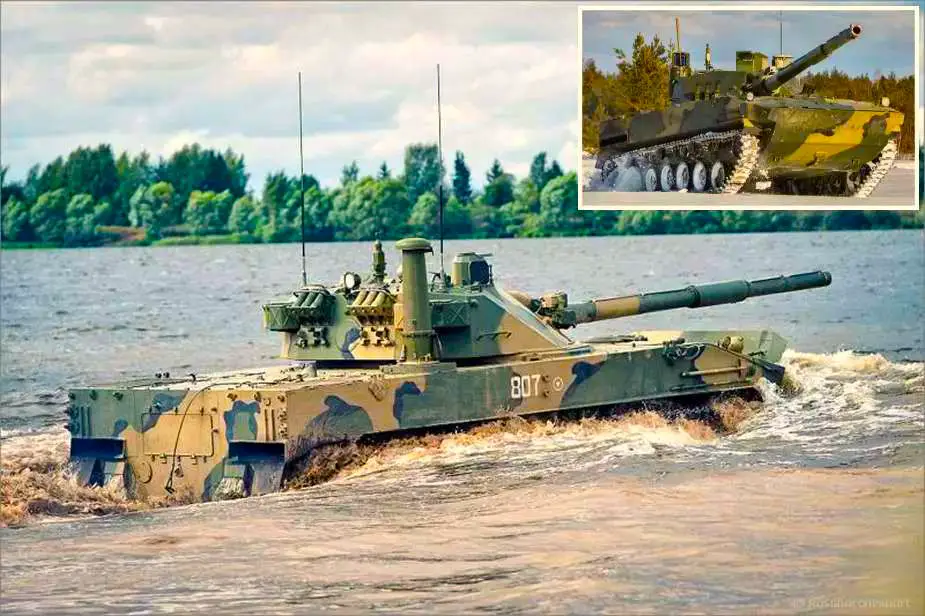Breaking news
Russia keen to propose Sprut-SDM1 amphibious light tank to Indian Army.
Russia's state-owned arms company, Rosoboronexport, has expressed its interest in participating in the bidding process to supply light tanks and the Future Infantry Combat Vehicle (FICV) to India. This announcement was made by Rosoboronexport's CEO, Alexander Mikheyev, during the International Aerospace Exhibition at the Dubai Airshow in 2023, echoed by Ashish Dangwal in Eurasian Times.
Follow Army Recognition on Google News at this link

2S25M Sprut-SDM1 amphibious light tank (Picture source: Rosoboronexport)
The collaboration between Russia and India aims to unveil a light tank and an advanced infantry fighting vehicle as part of the Indian Ministry of Defense's FICV project tender. This initiative aligns with India's 'Make in India' program, emphasizing technological sovereignty and independent industrial development.
Russia has a history of cooperation with Indian enterprises, aligning with the principles of 'Make in India' and 'Self-Reliant India' programs. Their successful joint ventures include projects like Su-30MKI fighters, T-90 tanks, BMP-2 infantry fighting vehicles, and the Kalashnikov AK-203 assault rifles.
While the specific light tank and FICV offerings were not disclosed in the announcement, there are indications that Russia may propose its Sprut-SDM1 light amphibious tank for India's light tank tender. Additionally, the BMP-III, with enhanced armament and capabilities, has been offered for consideration in the FICV project.
The FICV program is significant for India as it seeks to replace aging Soviet/Russian infantry fighting vehicles (BMP-1 and BMP-2) that have exceeded their operational lifespan. These outdated vehicles are deployed extensively but lack the capabilities required for modern warfare.
Initially, the Indian military plans to acquire 2,600 modern combat vehicles with an estimated contract value exceeding US$10 billion. However, the tender terms stipulate that only Indian companies can participate as the main contractors. Prominent Indian private sector defense firms, such as Mahindra and Mahindra, Reliance Defence, L&T, Tata Motors, and Bharat Forge Ltd., have expressed interest in the FICV project.
Despite its importance, the FICV program has faced challenges since its initiation in 2008. These challenges include political indecision, bureaucratic apathy, and frequent changes in procurement practices, hindering the Indian Army's urgent need for the Future Infantry Combat Vehicle. The FICV was originally required to be amphibious, equipped with a manned turret, and armed with top-attack anti-tank guided missiles. The initial plan aimed to induct FICVs by 2025, but experts believe that India is unlikely to meet this timeline given the current trajectory.
The necessity for light tanks and the FICV has become exceptionally crucial for the Indian Army due to China's significant reinforcement of armored resources in the Tibet Autonomous Region, which shares a border with India. These modern combat vehicles are vital for enhancing India's defense capabilities in the face of evolving security challenges.
Furthermore, Russia's expression of interest in supplying light tanks and the FICV to India comes amid reports of potential joint efforts between the US and India for the co-production of the Stryker armored fighting vehicle (AFV). While the Stryker deal could reduce India's reliance on Russian weaponry, it poses a significant challenge for Indian defense manufacturers who have heavily invested in developing indigenous weapon systems.
In conclusion, Russia's announcement of its intent to supply light tanks and infantry fighting vehicles to India highlights the importance of strengthening defense cooperation between the two nations. The collaboration seeks to modernize India's armored forces and aligns with India's 'Make in India' initiative. However, the FICV program faces challenges, and India must prioritize the timely procurement of modern combat vehicles to address evolving security threats in the region.
Defense News November 2023























